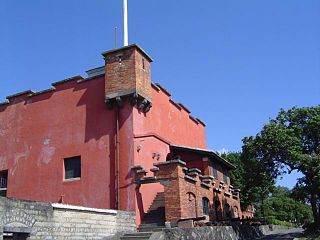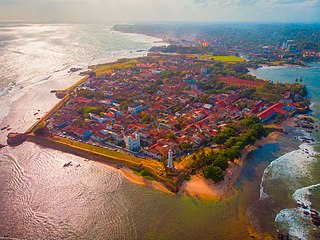 W
WThe Batticaloa Fort was built by the Portuguese in 1628 and was captured by the Dutch on 18 May 1638. From 1745, the fort was used by the British.
 W
WThe Castle of Good Hope known locally as the Castle or Cape Town Castle is a bastion fort built in the 17th century in Cape Town, South Africa. Originally located on the coastline of Table Bay, following land reclamation the fort is now located inland. In 1936 the Castle was declared a historical monument and following restorations in the 1980s it is considered the best preserved example of a Dutch East India Company fort.
 W
WThe Chavonnes Battery was a fortification protecting Cape Town, South Africa, built in the early 18th century. It is now a museum and function venue.
 W
WChrist Church Malacca is an 18th-century Anglican church in the city of Malacca City, Malaysia. It is the oldest functioning Protestant church in Malaysia and is within the jurisdiction of the Lower Central Archdeaconry of the Anglican Diocese of West Malaysia.
 W
WDejima was a Portuguese and subsequently Dutch trading post at Nagasaki, Japan from 1634 to 1854. Dejima was also the location for trade with the Chinese at the time, and thus the only place designated for foreign trade and exchange during the historical Japanese Edo period.
 W
WFengguiwei Fort is a former Dutch fortification located in Magong, Penghu, Taiwan. The fort sat atop a small hill on a peninsula across the bay from Magong Harbor. As of today, little of the original structure remains.
 W
WFort Provintia or Providentia, also known as Chihkan Tower, was a Dutch outpost on Formosa at a site now located in West Central District, Tainan, Taiwan. It was built in 1653 during the Dutch colonization of Taiwan. The Dutch, intending to strengthen their standing, sited the fort at Sakam, about 2 miles (3.2 km) due east from modern-day Anping. During the Siege of Fort Zeelandia (1662), the fort was surrendered to Koxinga, but was later destroyed by an earthquake in the 19th century. It was rebuilt as Chihkan Tower afterwards.
 W
WFort Rotterdam is a 17th-century fort in Makassar on the island of Sulawesi in Indonesia. It is a Dutch fort built on top of an existing fort of the Gowa Kingdom. The first fort on the site was constructed by the a local sultan in around 1634, to counter Dutch encroachments. The site was ceded to the Dutch under the Treaty of Bongaya, and they completely rebuilt it between 1673 and 1679. It had six bastions and was surrounded by a seven meter high rampart and a two meter deep moat.
 W
WFort San Domingo is an historic fortress in Tamsui District, New Taipei, Taiwan. It was originally a wooden fort built in 1628 by the Spanish Empire, who named it "Fort San Domingo". However the fort was then destroyed by the Spanish themselves, after losing the Second Battle of San Salvador to the Dutch Empire in 1642. After the battle, in 1644, The Dutch rebuilt a fort in the original site, and renamed it "Fort Antonio". Since the Dutch were called "Red Haired People" by the Han immigrants during the time, the fort was then nicknamed "Fort Red Hair".(Chinese: 紅毛城; Pe̍h-ōe-jī: Âng-mn̂g-siâⁿ; lit.: 'ang mo fort').
 W
WFort Zeelandia was a fortress built over ten years from 1624 to 1634 by the Dutch East India Company (VOC), in the town of Anping on the island of Formosa, the former name of Taiwan Island in Taiwan, during their 38-year rule over the western part of the island. The site had been renamed several times as Orange City (奧倫治城), Anping City (安平城), and Taiwan City (臺灣城); the current name of the site in Chinese is 安平古堡(lit. 'Anping Old Fort').
 W
WGalle Fort, in the Bay of Galle on the southwest coast of Sri Lanka, was built first in 1588 by the Portuguese, then extensively fortified by the Dutch during the 17th century from 1649 onwards. It is a historical, archaeological and architectural heritage monument, which even after more than 432 years maintains a polished appearance, due to extensive reconstruction work done by Archaeological Department of Sri Lanka.
 W
WKatuwana Fort, is an inland fort constructed by the Dutch in 1646.
 W
WThe Oost-Indisch Huis is an early 17th-century building in the centre of Amsterdam. It was the headquarters of the Amsterdam chamber of the Dutch East India Company. It is a listed Dutch national heritage site (rijksmonument).
 W
WThe Stadthuys is a historical structure situated in the heart of Malacca City, the administrative capital of the state of Malacca, Malaysia in a place known as the Red Square. The Stadhuys is known for its red exterior and nearby red clocktower. It was built by the Dutch in 1650 as the office of the Dutch Governor and Deputy Governor.
 W
WVan Riebeeck's Hedge is a hedge planted in 1660 by Jan van Riebeeck to mark the border of the Dutch East India Company settlement in what is now Cape Town, South Africa. The hedge consisted of indigenous wild almond trees. Sections of the hedge can still be seen in Kirstenbosch National Botanical Garden and Bishopscourt, and have been declared a National Monument.
 W
WThe Wiebbe Hayes Stone Fort on West Wallabi Island is the oldest surviving European building in Australia and was built by survivors of the Batavia shipwreck and massacre. West Wallabi Island is 63 km (39 mi) from the coast of Western Australia.